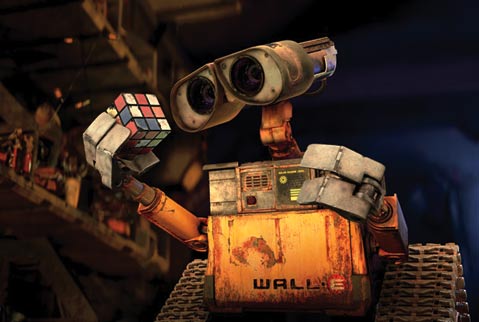WALL-E.
The voices of Ben Burtt, Sigourney Weaver, and Kathy Najimy star in an animated film written by Jim Capobianco and Andrew Stanton and directed by Stanton.

WALL-E presents us with an Earth completely devastated by consumerism and corporate greed. There, the sky’s gone beige from tsunami-sized sandstorms that roll regularly through a deserted megalopolis and mountains of waste and ponds of turgid viscous liquid. This mess is presided over by a cute trash-compacting robot and his indestructible cockroach companion, left with the Herculean task of cleaning up the desolate dump one metallic hunk at a time. Mostly what we notice, though, are ironic billboards, demanding consumption as if the subliminal messages from John Carpenter’s They Live had been rendered visible.
Don’t assume this is preachy enviro-prop theater, though. Because even though robot WALL-E’s directive is cleaning up the place 700 years after human abandonment, his passion is collecting the odd and fascinating detritus of the culture: Rubik’s cubes, sporks, and fire extinguishers, among a myriad of other carefully selected relics, which our Chaplin-esque hero enshrines in his bunker of solitude where he also moons over iPod screenings of Hello, Dolly! The slyly funny movie conducted for the first 45 minutes without any dialogue thus becomes a very sophisticated examination of the intersection of life with technology as both a love poem and a cautionary tale.
Pixar’s follow-up to the utterly perfect Ratatouille has been widely and justifiably hailed. You may agree it’s not as successful a movie, though it’s a more spectacular cartoon. Even if that fine distinction doesn’t matter to most moviegoers, it’s clear that the often mind-blowing technical triumphs of WALL-E will continue to reward frequent re-viewings. Just the mix of “live” actors with flabby cartoon humans works successfully against expectations. And the outer space vistas are breathtaking, too.
Common sense says there should be no way to frame an anti-corporate message in a film made on computers funded by Disney and, gratifyingly, WALL-E‘s more complex than that. It says that that technology’s hurting us while it makes us happier. Luckily, this cartoon has a tiny seedling literally at its core. A thing called hope summoned after the planet is basically dead. It’s lifeboat humor to make future generations think.



